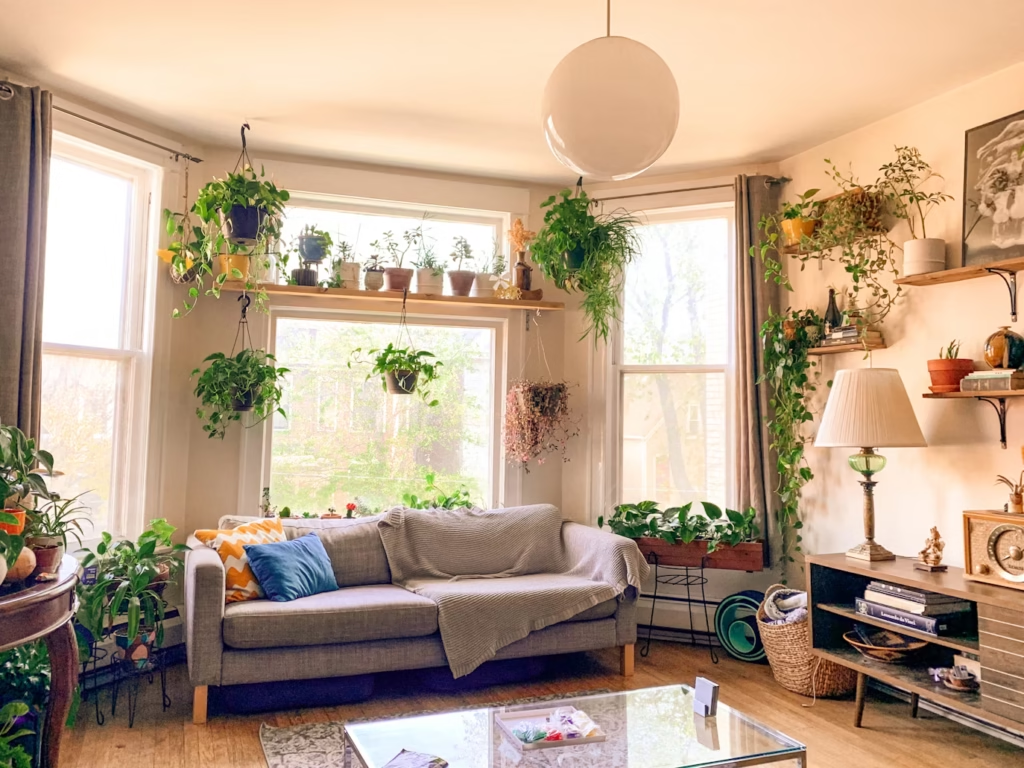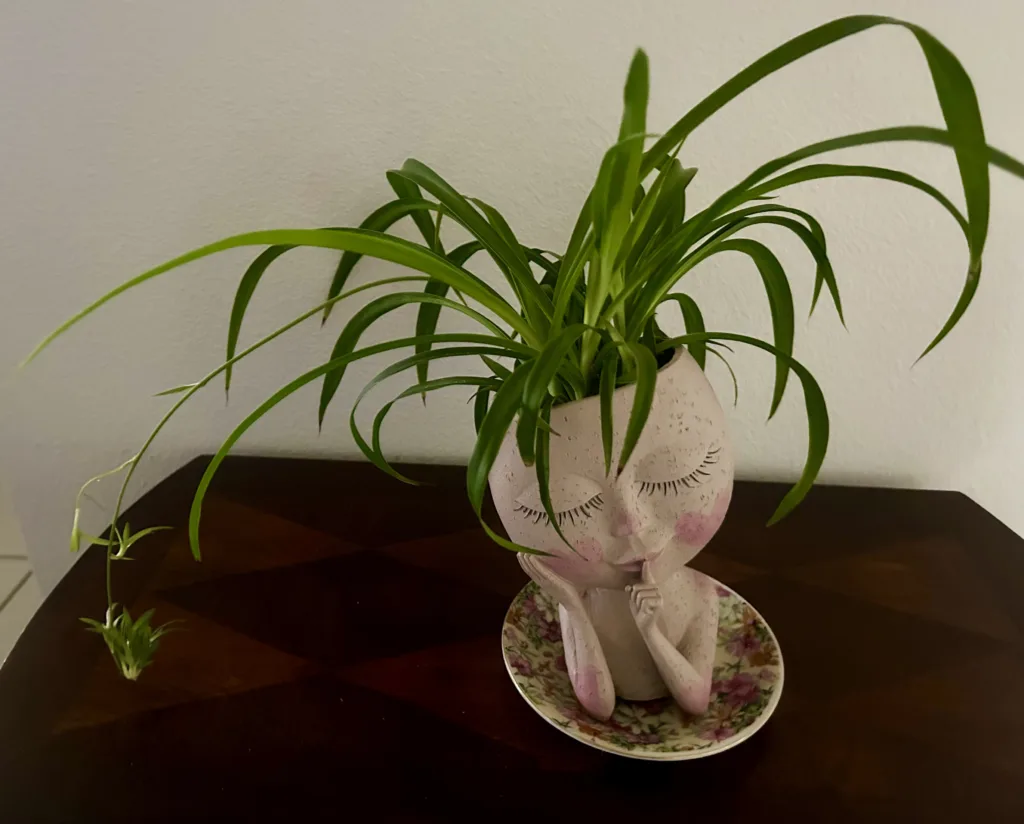
Adding plants to your home decor is one of the easiest and most affordable ways to refresh your space. Plants instantly bring life, texture, and color to any room, and many varieties are surprisingly easy to grow. Whether you want to create a cozy corner with cascading vines or place a single dramatic plant to draw the eye, the right greenery can transform your home. In this post, you’ll discover easy-to-grow houseplants along with ideas for how to display them beautifully in your space.
Pothos (Epipremnum aureum)
Pothos is one of the most low-maintenance houseplants and a great choice for beginners. It tolerates low light, thrives on neglect, and grows quickly. You can let it trail from a hanging basket, place it on a shelf, or train it to climb a support. For more in depth post on how to grow and care for Pothos just click here.
Styling Tip: Drape pothos from a high bookshelf or place it in a hanging macramé holder near a window. Its long, trailing vines create a lush, natural feel in any room.
Snake Plant (Sansevieria trifasciata)
Snake plant, also known as mother-in-law’s tongue, is a striking plant with tall, upright leaves. It handles low light and dry air well, making it ideal for bedrooms, hallways, and offices. For more in depth post on how to grow and care for Snake Plant just click here.
Styling Tip: Use a tall ceramic or concrete pot to emphasize the plant’s architectural shape. Place it beside furniture with clean lines to add vertical interest and modern appeal.
ZZ Plant (Zamioculcas zamiifolia)
The ZZ plant tolerates low light, irregular watering, and dry indoor air. Its waxy, deep green leaves add a glossy texture that fits well with contemporary or minimalist decor. For more in depth post on how to grow and care for ZZ Plant just click here.
Styling Tip: ZZ plants look stunning in glossy black or gold planters. Position one on a low bench or next to a leather armchair for a bold but elegant look.
Peace Lily (Spathiphyllum)
Peace lilies offer graceful white blooms and glossy green leaves. They clean the air and thrive in indirect light. They do need regular watering but quickly bounce back from occasional neglect. For more in depth post on how to grow and care for Peace Lily just click here.
Styling Tip: Place a peace lily in a white or cream pot to highlight its blooms. It looks beautiful in entryways, bathrooms, or near sofas where it can soften the space.
Spider Plant (Chlorophytum comosum)
Spider plants are cheerful and easy to grow. They produce small offshoots, or “babies,” that hang like ornaments. They thrive in bright, indirect light and only need moderate watering. For more in depth post on how to grow and care for Spider Plant just click here.

Styling Tip: Hang a spider plant in a woven basket near a window, or let it spill from a floating shelf. I love the way I styled this one in one of my pot head planters. Its playful look works well in kitchens, sunrooms, or kid-friendly spaces.
6. Philodendron Heartleaf (Philodendron hederaceum)
This classic houseplant is a fast grower with heart-shaped leaves. It thrives in bright, indirect light and needs only moderate watering. It trails easily and can also be trained to climb. For more in depth post on how to grow and care for Philodendron just click here.
Styling Tip: Let it trail over the edge of a bookshelf or kitchen cabinet. You can also use a moss pole to grow it upward for a tropical look.
Aloe Vera
Aloe vera isn’t just useful—it’s beautiful, too. Its fleshy, spiked leaves add a sculptural element to your decor. It prefers bright light and little water, making it perfect for sunny windowsills. For more in depth post on how to grow and care for Aloe Vera just click here.
Styling Tip: Place aloe in a shallow clay pot on a kitchen counter or bathroom windowsill. Pair it with other succulents for a small indoor desert garden.
Rubber Plant (Ficus elastica)
Rubber plants are known for their large, glossy leaves and upright growth. They prefer bright, indirect light and regular watering but are generally tough and forgiving. For more in depth post on how to grow and care for Rubber Plant just click here.
Styling Tip: Place a rubber plant in a statement pot and use it as a focal point in a living room or dining area. Its height helps balance large furniture or open floor plans.
Dracaena Marginata
With its slender trunk and spiky, colorful leaves, Dracaena marginata adds height and drama. It prefers bright, indirect light and only occasional watering. For more in depth post on how to grow and care for Dracaena just click here.
Styling Tip: Use this plant to anchor a modern space. Its sculptural shape fits beautifully in tall, narrow planters. Place it beside a window for a light-loving companion.
Tips for Arranging Plants in Your Home
Now that you know which plants to grow, it’s time to think about where and how to place them for the best visual impact. Mixing plant heights, textures, and containers can create a cohesive yet dynamic look. Here are a few simple ideas to try.
Create a Plant Shelf or Gallery Wall
Group 3–5 plants on open shelving with varying heights and leaf shapes. Combine trailing plants like pothos with upright plants like snake plant or ZZ plant. Use pots in similar tones for a unified look, or mix textures like matte ceramic, wood, and glass for variety.
Style Corners with Tall Plants
Don’t leave empty corners bare. Instead, add a tall plant like a rubber plant or Dracaena in a bold pot. Pair it with a small stool or basket to elevate the look.
Add Plants to the Bathroom
Bathrooms are great for plants that like humidity, such as peace lily or spider plant. Place one on the counter, hang one from the ceiling, or sit one on the toilet tank to liven up the space.
Group Plants by Lighting Needs
Place sun-loving plants like aloe vera, rubber plant, or philodendron near south- or west-facing windows. In contrast, keep low-light lovers like ZZ plant and pothos plant in shadier areas like offices, hallways, or bedrooms.
Use Unusual Planters
Try placing plants in teacups, baskets, woven bins, or even old lanterns for a creative touch. Just make sure containers have drainage holes or use a cache pot system (where the plant remains in a plastic nursery pot inside the decorative one).
Hang Plants at Different Heights
Use ceiling hooks, wall-mounted brackets, or hanging shelves to elevate some of your plants. This adds visual movement and makes the space feel more alive and layered.
Final Thoughts
Bringing plants into your home decor doesn’t need to be complicated or intimidating. With just a little care, the plants above will thrive and add beauty to your space all year long. Whether you’re decorating a sunny living room, a dim hallway, or a bright bathroom, there’s a plant that fits your needs. With creative styling and a touch of green, your home will feel more inviting, balanced, and alive. Start with one or two of these easy-care options, and watch your indoor garden grow from there.
Please be sure to check out my Gardening Blog Post Page for more tips on all types of gardening. Including Seed Saving, Seed Starting, Orchids, Water Gardening, Coldframe Gardening, Indoor Bulb Gardening, Hydroponics, Container Gardening, Mums, Herbs, African Violets, planting Bulbs, Flower Gardening, Vegetable and Fruit Gardening, Indoor Houseplants of all kinds, Bonsai, Cactus, Succulents, Hanging plants, Deer resistant plants and even Bird, Bee, Butterfly and Hummingbird Gardens!
